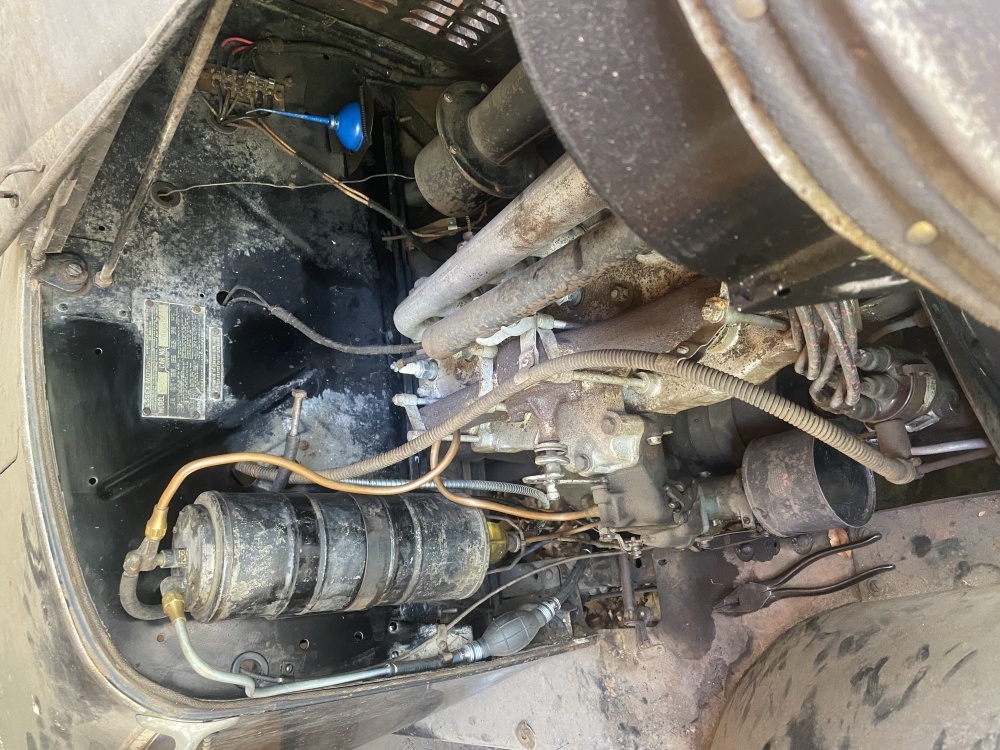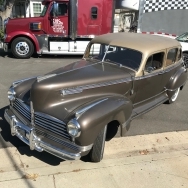Electric Fuel Pump
I'm getting ready to swap out for an electric fuel pump on my 29 Essex Super Six, and I wanted to request suggestions and tips for which products to use, and what not to do as well. Thanks in advance!
0
Comments
-
Be sure to put a regulator after the pump. It's my understanding, you only want about 2 PSI going to the carb.0
-
The Carter P4259 is a 6-volt rotary vein pump that has an output of about 4-8 psi.You could consider a return line to the tank of a smaller diameter or a restriction in a return line as a method to keep the pressure down. Tee the return line near the carburetor.
0 -
If you are running the original Marvel carburetor with cork float you are going to have trouble with flooding with anything heavy than gravity pressure.0
-
Easiest is to stay with the original Stewart Warner Vacuum tank which operates at the required pressure. Th
0 -
I'm not so sure using the original vacuum tank is the easiest. It doesn't want to run, and from the many other owner conversations that I've read, there are a dozen leak points and weak links that could be possible culprits. I figured people are running the electric pump to avoid all of these factors.0
-
I have run my 1928 Essex for 66 years, and the vacuum tank has failed but once, 50 years ago. Soldered the cracked float and no more problems. Far better than any electric or mechanical pump.0
-
I like the made in NZ FuelFlow range of pumps, they make two low pressure versions the 060 is the 6V and the 015L is the 12V. They have plenty of capacity, I've put an 015L on a 600 cu in Waukesha engine in an 8 ton half track logging tractor that gets 5mpg, a 29 Essex will be a breeze.
https://fuelflow2020.nz
0 -
Sometimes talking to other owners does not yield the best information. If they are not at least a bit mechanically inclined they may just parrot what in fact is an expeditious solution, not necessarily the best. The trade publications I have read echo what Geoff expresses here. I am humbled by the level of expertise and experience he brings to this forum. We are lucky to have him.Regards, Tom0
-
I am new to Essex, and new to the forum, so I highly depend on the information I read on here. I'm not great with mechanical repair myself, so I need something that is dependable. That's what has drawn me to lean towards electric fuel delivery. However, I realized early on (from reading many of his contributions on this forum) that Geoff's opinion holds a 10x value due to his experience.
If I were more mechanically inclined, and if my fuel system was known to be in good working order, I would have no problem keeping it original, especially since everything else appears to be original on it. And I respect that value.
Unfortunately, I'm depending greatly on a local mechanic that has "some" experience with the older fuel systems, and I'm not sure if he (we) can get it straightened out without going new. I have to sell this Essex (all original '29, restored 25 years ago) in order to keep my other (unrestored '29 getting a Chevy 350 and other modern updates).0 -
Where are you located, perhaps there might be a Hudson guy near by.
regards, Tom0 -
I've been looking for one. I'm in the KC Missouri area.0
-
For what this is worth, My other car for the past 20 years is a 1950 MG TD, lots of Lucas stuff. My experience has been the components themselves are quite good, the connections/connectors leave much to be desired.Regards, Tom0
-
I looked at the low pressure fuel pump offerings..... I didn't see anything that tells just what the pressure generated, is. Do you know the PSI output?Old Fogey UK said:The SU electric pumps are rated as the best available here in the UK.
By no means inexpensive but said to be utterly reliable - and, to reassure American friends, they're not made by Lucas !
SU Fuel Pumps - The Green Spark Plug Company (gsparkplug.com)0 -
If need be a pressure reduction valve could be added inline. - and the pressure desired set.0
-
Lucas Prince of Darkness
a gentleman does not go motoring about after dark0 -
The S-W vacuum tank was an incredible ingenious device. When restored and set up properly they work forever. Their only problem is getting them fixed the first time AND understanding how to test them. ("Yeah, I fixed it but does it work?")
My experience comes from repairing the one on my 1929 Cadillac and 1926 Lincoln.
First buy your rebuild parts here: (he can rebuild yours also, but the turnaround is lengthy)
http://www.classicpreservation.com/vactankkits.html
The #1 failure is the pot metal lid. The inner and outer tank are steel and the float is brass if they are seriously damaged you can see and replace what is needed. The pot metal lid is fragile and can crack and not hold vacuum. Reproduction lids are being made in Australia but they are not cheap. If cracked and leaking can yours be JB welded?
Testing - It IS a vacuum device. You must make sure that it holds vacuum!
After disassembly, cleaning and reassembly, take it to a modern type car that has a good reliable vacuum. There are four ports on the top
1. vacuum from engine
2. fuel from the tank (fuel to the carb in on the bottom)
3. vent for the inner tank (it opens & closes with the float)
4. blank hole with a plug in it. (this was intended to fill the inner tank for priming)
Tap into the blank hole and connect it to a vacuum gauge. (A nipple with a rubber hose to your vacuum gauge will work)
Plug up the fuel from tank port
Connect the "vacuum from engine port" to the good running modern car that will pull 18"-20" of vacuum.
Hold the tank vertical - you should see vacuum rise on the gauge (this is vacuum in the inner tank) If you pinch the vacuum from the running engine it should hold this vacuum It wont hold it for a long time, but enough to show that the lid & inner tank can hold vacuum.
With it holding vacuum, then flip the tank upside down. This will move the float to the top and change the position of the valves in the lid. (simulating the inner tank full of fuel) When the float hits the top and the valves are activated you should lose the vacuum in the (inner) tank. The valves vent the vacuum and allow the fuel to move into the outer tank since you have it upside down and there is no fuel all you will see is the loss of vacuum.
Turn the tank right side up and the float will fall, reset the valves and you should see vacuum rise again.
This tests the lid for leaks and the needle valves for leaks. IF you cannot gain and lose vacuum inside the tank, something needs looking at.
You can also simulate the in use vacuum tank action by connecting it to vacuum, mounting it upright and run lines from the fuel inlet and fuel to carb ports and put the lines into a bucket of fuel. With good vacuum it should suck the fuel into the inner tank, fill until the float hits the needle valves, then empty into the outer tank and flow back into the bucket. As the float cycles you can watch the vacuum rise and fall on the vacuum gauge. Kinda fun to watch actually.
The other point of failure is the little needle valves in the lid. The cannot be removed BUT you can clean and reseal them by putting toothpaste on the needle and seat and rotating the shaft to polish and reseal them.
The flapper valve at the bottom of the inner tank can be checked by putting the tank into water and seeing if the valve can seal against the pressure. A light sandpapering can clean up defects in this valve. (but dont sand too much it is soft)
It is not uncommon to have an electric pump AS A BACK UP-PRIMING device. (using switch under the dash for momentary function)
If the car has been parked for awhile the electric pump can add some fuel to the tank for starting or if you are climbing a long hill and forgot to back off the accelerator to give the tank vacuum, then a few SECONDS of electric pump can add some fuel to the tank.
The problem with electric pumps on ancient updraft type carbs is the the needle and seat was designed to function only against gravity feed pressure. 0.5 to 1 psi(?) Sure use a pressure regulator (how low do they go) but at 2,3, 4 PSI you can open the needle and seat and flood gas onto the engine and make and extreme fire hazard!
0 -
Great comment. Very helpful for anyone with a vacuum tank equipped car. Well done.
regards, Tom0 -
 There’s nothing more satisfying than putting your ear to the fuel line and listening to the mechanism click through it’s cycle!
There’s nothing more satisfying than putting your ear to the fuel line and listening to the mechanism click through it’s cycle!
Just as Hudson intended!0
Categories
- 36.9K All Categories
- 111 Hudson 1916 - 1929
- 20 Upcoming Events
- 92 Essex Super 6
- 28.6K HUDSON
- 569 "How To" - Skills, mechanical and other wise
- 995 Street Rods
- 151 American Motors
- 178 The Flathead Forum
- 49 Manuals, etc,.
- 78 Hudson 8
- 44 FORUM - Instructions and Tips on using the forum
- 2.8K CLASSIFIEDS
- 606 Vehicles
- 2.1K Parts & Pieces
- 77 Literature & Memorabilia
- Hudson 1916 - 1929 Yahoo Groups Archived Photos







